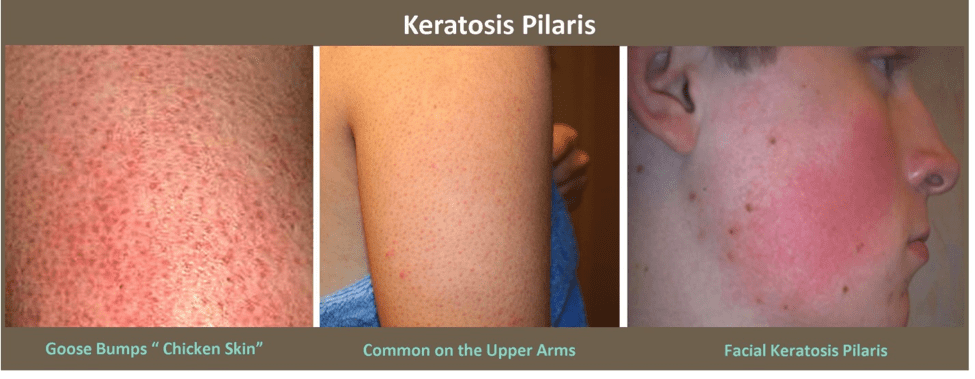COSMETIC DERMATOLOGY AND SKIN CARE FOR Plano, Frisco, and the Dallas Fortworth metroplex in Texas
Keratosis pilaris(KP) is a common and harmless condition where the skin becomes rough and bumpy, as if covered in permanent goose pimples. These minute, rough bumps with their nutmeg grater-like texture are most frequently scattered along the upper arms and thighs. Less often, the buttocks, forearms and upper back may be affected. There are also rare variants of keratosis pilaris that can affect the eyebrows, face and scalp, or the entire body.
Classically the condition appears in early childhood, often around the age of two or three. Since the rash is associated with, and worsened by dryness of the skin, most people experience a clear-cut seasonal variation – generally worse in the winter.

What causes Keratosis Pilaris?
Keratosis pilaris (KP) runs in families and is inherited from your parents. If one parent has the condition, there’s a one in two chance that any children they have will also inherit it. KP occurs when too much keratin builds up in the skin’s hair follicles. Keratin is a protein found in the tough outer layer of skin, which causes the surface of the skin to thicken (hence the name “keratosis”). The excess keratin blocks the hair follicles with plugs of hard, rough skin. The tiny plugs widen the pores, and cause inflammation within each hair follicle that creates embarrassing pinpoint red or brown polka dots to form beneath each miniature mound of keratin. Sometimes, a hair is unable to reach the surface and becomes trapped beneath the debris. During puberty, this is an ideal set-up for triggering follicular acne. But more often than not, KP improves with age.
How Would I Know if I had Keratosis Pilaris?
You can confirm that you have keratosis pilaris when you consult with a board-certified dermatologist. You may not need any special tests to confirm what is causing your symptoms. Your dermatologist can perform a visual examination of the bumps and texture of your skin. This alone may confirm keratosis pilaris as the cause of your symptoms.
Does Keratosis Pilaris Need to be Treated by a Dermatologist?
Maybe. As much as we’d like to have a definitive answer about how to manage keratosis pilaris, we don’t. Sometimes, this condition resolves on its own and all you need to do is manage it with gentle home care. This may include the use of gentle cleansers and exfoliation and appropriate moisturizers used at least once a day. If home remedies do not achieve the desired effect, then consulting with a dermatologist is the next best step. Your doctor may recommend specific actions, products, or prescriptions to gain control of your bumpy skin.
Is Keratosis Pilaris Dangerous?
No. This skin condition is not dangerous. It does not increase your risk of skin cancer or other chronic dermatologic conditions. It can be frustrating, yes. However, we can help you get the upper hand on it so you can reclaim your comfort and confidence!
Is Treatment for Keratosis Pilaris Painful?
There are a few different ways that you can treat keratosis pilaris. None of them should be painful. If your dermatologist recommends procedures like microdermabrasion or laser treatment to reduce your symptoms, you might experience minor sensations like a sandpaper feel or warmth. Laser treatments sometimes cause a snapping sensation on the skin. These are not painful but they may feel odd. They are also only momentary.
Is there a Cure for Keratosis Pilaris?
There isn’t a cure for this condition but there are options for managing the bumps and other symptoms that may occur. The good news about keratosis pilaris is that, according to research, the condition doesn’t seem to last a lifetime. It usually runs its course by around age 30. Until it subsides naturally, you and your dermatologist can implement ways to mitigate symptoms so you can remain comfortable and confident in the appearance of your skin!
How do you treat Keratosis Pilaris?
There’s no cure for keratosis pilaris, but you may be able to improve the rash by using soap-free cleansers, moisturizing and gently exfoliating (removing dead skin cells from the surface of the skin). It usually improves as you get older and sometimes disappears completely in adulthood.
At-home Treatments:
Treatment is all about smoothing away the bumps. Therapy can eliminate the bumps, improve the texture, eliminate acne-causing plugs, and improve the overall appearance. General skin care steps include;
- Use non-soap cleansers (Cetaphil, Fiona WRxIGHT MD Calm and Correct Cleanser) rather than soap – ordinary soap may dry your skin out and make the condition worse.
- Moisturize your skin when it’s dry. However, moisturizers (Cetaphil, Lubriderm) only reduce the dryness of your skin and won’t cure the rash. Creams containing salicylic acid, lactic acid (AmLactin) or Glycolic Acid (Fiona WRxIGHT MD 15% Refining Lotion) are thought to be the more effective.
- Use a humidifier to add moisture to the air inside your home. Increasing the humidity in the sleeping quarters has been shown to improve the rash.
- Gently rub the skin with an exfoliator (Fiona WRxIGHT MD MicroPolish) or pumice stone to exfoliate the rough skin and loosen the plugs– be careful not to scrub too hard and rub off layers of skin.
- Take lukewarm showers rather than hot baths.
In-office Treatments
No single treatment universally improves keratosis pilaris but many will see some improvement with the self -help options above. However, if you have become frustrated with the lack of improvement or need results quickly then Skin MD and Beyond is here to help.
Dr. Wright has several therapeutic options to offer her patients which can control the condition and appearance of keratosis pilaris. Treatment can include the following prescriptive treatments and medications:
Topical treatments: Dr. Wright can prescribe an array of prescriptive strength, specially mixed “designer” compound creams to help with exfoliation. As well, prescription vitamin A creams derived from retinoids can promote cell turnover and prevent the plugging of the hair follicle. Tretinoin (Retin-A, Renova, Avita) and tazarotene (Avage, Tazorac) are examples of topical retinoids.
Keratosis pilaris may also be treated with topical immunomodulators such as pimecrolimus (Elidel) or tacrolimus (Protopic). Although these products are approved for atopic dermatitis and eczema, their use would be considered off label for keratosis pilaris. These may be used in more resistant cases or when our patients have considerable skin redness or inflammation.
For the cosmetic concern of persistent skin discoloration, Dr. Wright can prescribe a variety of fading creams such as hydroquinone 4%, kojic acid, and azelaic acid 15-20%. As well, she offers a very effective non-prescriptive blend from her personal skincare line, Fiona WRxIGHT MD Skincare Radiance and her Complexion Correction Lotion. In addition her specially compounded lotions for particularly resistant skin discoloration may incorporate higher concentrations of hydroquinone 6%, 8%, and 10%.
Microdermabrasion/ DermaSweeps: For some people topical exfoliants and retinoids can cause skin irritations, such as severe dryness, redness and peeling, and as an alternative they may require an in-office treatment to promote exfoliation without the irritation. Incorporating a mild scrub (Fiona WRxIGHT MD Skincare Exfoliating Cleanser) with a series of Microdermabrasions or DermaSweeps will jumpstart your way to smoothness, and allow you to get back to the sleeveless weather of Texas!
Laser Treatments: Laser Treatments can help in two ways. For some, Keratosis Pilaris is caused by small coiled ingrown hairs that plug the follicle. Laser Hair Removal can be used to decrease hair growth in the affected area. For others, resurfacing the affected skin with a Fractional Resurfacing Laser have had some success in unplugging the follicles.
Laser treatments will require repeat sessions over the course of a few months, depending on your response.
It is important to remember that since Keratosis Pilaris is a chronic condition, treatment is ongoing and if discontinued, the protein build up will begin reforming around the hair follicles. Maintenance is the best way to maintain silky smooth skin. But, with the help of Skin MD and Beyond your keratosis pilaris is easy to control and you don’t need to suffer. Call today and get ready the summer season of sleeveless fashion!
